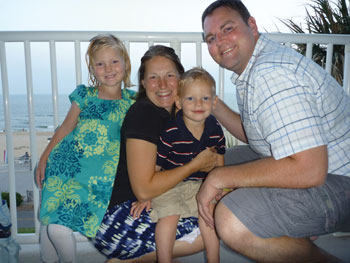Making it work on a modest budget
Dr. James Finlay has managed to pull off an impressive feat: He's helping raise two children with his wife, Megan, on a resident's salary in Southern California.
"We're pretty frugal people," he said. "It's enough for us to live on, but we're not saving a lot and taking trips to Europe."
Dr. Finlay works in Duarte, Calif., at the City of Hope Cancer Research Hospital. He's completing a dual residency and doctoral degree program, with his research focusing on breast cancer.

Laboratory animal medicine has been a passion of his since his sophomore year at Brigham Young University. For three years, he worked in a research laboratory while completing his undergraduate degree. After being accepted to veterinary college at Michigan State University, Dr. Finlay worked at the Department of Agriculture's Avian Disease and Oncology Laboratory in East Lansing, Mich., for two summers.
One perk associated with working in his field is the predictable schedule. Rarely does he have to be on call or work long hours, which is more conducive to family life, he said.
"I definitely want to be able to see my kids every day or almost every day, and this program allows me to do that," Dr. Finlay said. "I didn't want to go through four years of undergrad, four years of grad school, and three years of residency, blink, and miss everything. That was a consideration in choosing a specialty for me, as was financial compensation."
In fact, he had researched the salaries for laboratory animal veterinarians at the beginning and end of their careers to make sure he could provide enough for his family and pay off his sizeable loans from veterinary college.
"Maybe because it's so much money or because it's something I'm comfortable with," Dr. Finlay said, he doesn't think too often about his debt burden, which is just under $200,000. Most of the debt was accrued during veterinary college. Scholarships and income from his part-time job in the laboratory helped him get through BYU. His wife, who graduated two years before him, was working full time while he finished his undergraduate work.
He and his wife do not carry any credit card debt. And, neither feels compelled to have a new car or live in an upper-class neighborhood.
"We're good at doing well with what we have. We live a lifestyle I'd be comfortable with for a long time. Once I'm done with the residency, we'll probably up our standard of living a little, but I will probably want to pay off more than the minimum payment," he said.
Dr. Finlay said it's as simple as having reasonable expectations. If anyone goes into the field thinking they will live an extravagant lifestyle, they're going to be disappointed, for the most part.
"From my perspective, most people don't think that they're going into veterinary medicine to make a load of money. The education is very rigorous, similar to what human doctors go through. If the objective was money, that would probably be the route to go," Dr. Finlay said.
Instead, he places more value on his passion for laboratory animal medicine and time with his family.
“I figured I’m going to get done with schooling and residency in my early 30s, and I’ve got at least 30 years’ work ahead of me. I want to do something I really enjoy, because this is going to be a huge part of my life,” he said. “The debt—it will get paid down over time.”